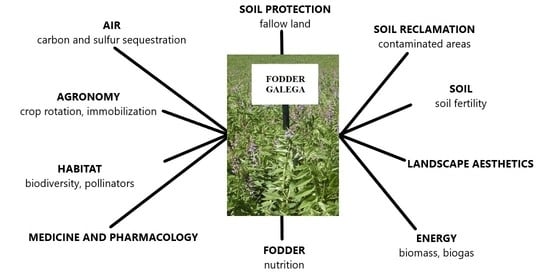Fodder Galega—A Versatile Plant
Abstract
1. Introduction
2. Origin and Botanical Traits
3. Agronomic Technology
4. Fodder Use
5. Use in the Protection of Fallow Land and Contaminated Soil
6. Energy Use
7. Usefulness in Medicine
8. Knowledge Gaps on Fodder Galega
- Examining the properties of the root system, allowing for a better utilisation of nutrients;
- The determination of suitability for fodder use in mixtures with grasses, especially in the system of extensive organic farming;
- Energy use of the fodder galega biomass not only from the monoculture of this plant, but mainly in mixtures with grasses;
- Examining the possibility of gasification of this plant, its mixtures with grasses or other energy sources and determining the fertilisation value of the resulting digestate;
- Defining the research on the subsequent impact on the yield of agricultural plants.
9. Conclusions
Author Contributions
Funding
Data Availability Statement
Conflicts of Interest
References
- Varis, E. Goat’s rue (Galega orientalis Lam.), a potential pasture legume for temperate conditions. J. Agric. Sci. Finl. 1986, 58, 83–101. [Google Scholar] [CrossRef]
- Nõmmsalu, H. The Nutritive Value of Fodder Galena (Galega orientalis Lam.); Research in Estonia: Saku, Estonia, 1994; pp. 25–34. [Google Scholar]
- Raig, H. Advances in the Research of the New Fodder Crop Galega orientalis Lam., Fodder Galega (Galega orientalis Lam.), Research in Estonia; The Estonian Institute of Agriculture: Saku, Estonia, 1994; pp. 5–24. [Google Scholar]
- Teleuţă, A.; Ţĭţei, V.; Coşman, S.; Lupan, A. Forage value of the species Galega orientalis Lam. under the conditions of the Republic of Moldova. Res. J. Agric. Sci. 2015, 47, 226. [Google Scholar]
- Rymuza, K.; Bombik, A. Application of a logistic function to describe the growth of fodder galega. J. Ecol. Eng. 2017, 18, 125–131. [Google Scholar] [CrossRef]
- Dubis, B.; Jankowski, K.J.; Sokólski, M.M.; Załuski, D.; Borawski, P.; Szempliński, W. Biomass yield and energy balance of fodder galega in different production technologies: An 11-year field experiment in a large-area farm in Poland. Renew. Energy 2020, 154, 813–825. [Google Scholar] [CrossRef]
- Rymuza, K.; Bombik, A.; Radzka, E. Application of selected non-linear functions to describe oriental goat’s rue (Galega orientalis Lam.) growth. Acta Agroph. 2018, 25, 373–383. (In Polish) [Google Scholar] [CrossRef]
- Harasimowicz-Hermann, G.; Ignaczak, S.; Andrzejewska, J.; Krasicka-Korczyńska, E.; Wojnowska, T.; Koc, J.; Sienkiewicz, S.; Szymczyk, S. Systemy konserwacji gleby odłogowanej-potencjalna produkcyjność ugoru obsianego w pierwszym roku. Bibl. Fragm. Agron. 1998, 5, 213–223. (In Polish) [Google Scholar]
- Hołubowicz-Kliza, B. The Benefits Associated with the Production of Fodder Galega; IUNG: Puławy, Poland, 2006; p. 12. (In Polish) [Google Scholar]
- Bussmann, R.W.; Batsatsashvili, K.; Kikvidze, Z.; Paniagua-Zambrana, N.Y.; Maisaia, S.; Sikharulidze, S.; Tchelidze, D. Galega orientalis Lam. Fabaceae. In Ethnobotany of the Mountain Regions of Far Eastern Europe; Springer: Berlin/Heidelberg, Germany, 2020; pp. 1–7. [Google Scholar] [CrossRef]
- Żarczyński, P.; Sienkiewicz, S.; Krzebietke, S. Accumulation of macroelements in plants on newly established fallows. J. Elem. 2008, 133, 455–461. [Google Scholar]
- Meripõld, H.; Tamm, U.; Tamm, S.; Võsa, T.; Edesi, L. Fodder galega (Galega orientalis Lam) grass potential as a forage and bioenergy crop. Agron. Res. 2017, 15, 1693–1699. [Google Scholar]
- Kalembasa, S.; Symanowicz, B. Effect of the infection of the goat’s rue (Galega orientalis Lam.) seeds on the dry matter yield and energy value. Acta Sci. Pol. Agric. 2003, 2, 157–162. (In Polish) [Google Scholar]
- Żarczyński, P.; Sienkiewicz, S. Content of macroelements in plants growing on fallow fields. J. Elem. 2007, 12, 217–224. [Google Scholar]
- Jeske, M.; Panka, D.; Ignaczak, S.; Pala, D. The effect of different organic fertilization on fungi colonizing plant roots and seeds of fodder galega (Galega orientalis Lam.). Zesz. Probl. Postępów Nauk. Rol. 2015, 580, 25–33. (In Polish) [Google Scholar]
- Symanowicz, B.; Kalembasa, S.; Jaremko, D.; Niedbała, M. Effect of nitrogen application and year on concentration of Cu, Zn, Ni, Cr, Pb and Cd in herbage of Galega orientalis Lam. Plant Soil Environ. 2015, 61, 11–16. [Google Scholar] [CrossRef]
- Møller, E.; Hostrup, S.B.; Boelt, B. Yield and quality of fodder galega (Galega orientalis Lam.) at different harvest managements compared with lucerne (Medicago sativa L.). Acta Agric. Scand. Sect. B Soil Plant Sci. 1997, 47, 89–97. [Google Scholar]
- Nõmmsalu, H.; Meripõld, H.; Metlitskaja, J.; Raig, H. Fodder galega (Galega orientalis Lam.): A promising new leguminous forage plant. Seed Sci. Technol. 1996, 24, 359–364. [Google Scholar]
- Meripõld, J.; Loiveke, H.J.; Müür, J. The effect of differences of conventional and organic farming agrotechnical measures on the compliance of the fodder galega ‘Gale’seed production to the certification requirements. Agron. Res. 2009, 7, 400–405. [Google Scholar]
- Baležentienė, L.; Spruogis, V. Experience of fodder galega (Galega Orientalis Lam.) and traditional fodder grasses use for forage production in organic farm. Vet. Med. Zoot. 2011, 56, 19–26. [Google Scholar]
- Jasinskas, A.; Zaltauskas, A.; Kryzeviciene, A. The investigation of growing and using of tall perennial grasses as Energy crops. Biomass Bioenergy 2008, 32, 981–987. [Google Scholar] [CrossRef]
- Lindström, K.; Sarsa, M.L.; Polkunen, J.; Kansanen, P. Symbiotic nitrogen fixation of Rhizobium (Galega) in acid soils, and its survival in soil under acid and cold stress. Plant Soil 1985, 87, 293–302. [Google Scholar] [CrossRef]
- Zav’yalova, N.E.; Voloshin, V.A.; Kazakova, I.V. Using the potential longevity of the perennial legume Galega orientalis to preserve the fertility of soddy-podzolic soil in the Cis-Urals. Russ. Agric. Sci. 2015, 41, 237–240. [Google Scholar] [CrossRef]
- Symanowicz, B.; Becher, M.; Kalembasa, S.; Jeżowski, S. Possibilities of using fodder galega in the energy sector and agriculture. Appl. Ecol. Environ. Res. 2019, 17, 2677–2687. [Google Scholar] [CrossRef]
- Sienkiewicz, S.; Wojnowska, T.; Pilejczyk, D. Plonowanie rutwicy wschodniej (Galega orientalis Lam.) oraz zawartość związków organicznych w zależności od zróżnicowanego nawożenia fosforowo-potasowego. Zesz. Probl. Post. Nauk Roln. 1999, 468, 223–232. (In Polish) [Google Scholar]
- Żarczyński, P.J.; Sienkiewicz, S.; Wierzbowska, J.; Mackiewicz-Walec, E.; Jankowski, K.J.; Krzebietke, S.J. Effect of land protection on the content of mineral nitrogen in soli. Fresen. Environ. Bull. 2019, 28, 4506–4513. [Google Scholar]
- Adamovich, A.M. Productivity and yield quality of fodder galega (Galega orientalis Lam.)—Grass mixed swards. Plant Nutr. 2001, 92, 1008–1009. [Google Scholar]
- Andrzejewska, J.; Ignaczak, S. Effectiveness of symbiosis between fodder galega (Galega orientalis Lam.) and Rhizobium galegae on fallow land. Electron. J. Pol. Agric. Univ. Ser. Agron. 2001, 4, 2. [Google Scholar]
- Eryashev, A.P.; Timoshkin, O.A. The Efficiency of Eastern Galega (Galega orientalis) Cultivation. Int. J. Emerg. Technol. 2020, 11, 910–914. [Google Scholar]
- Ignaczak, S. Productivity of seed plantations of fodder galega (Galega orientalis Lam.) cultivated extensively. J. Res. Appl. Agric. Eng. 2010, 55, 122–127. [Google Scholar]
- Ignaczak, S.; Szczepanek, M. Wartość przedplonowa rutwicy wschodniej dla pszenicy ozimej. Zesz. Probl. Post. Nauk Rol. 2005, 507, 245–251. (In Polish) [Google Scholar]
- Sienkiewicz, S.; Żarczyński, P.J.; Krzebietke, S.J.; Wierzbowska, J.; Mackiewicz-Walec, E.; Jankowski, K.J. Effect of land conservation on content of organic carbon and total nitrogen in soil. Fresen. Environ. Bull. 2017, 26, 6517–6524. [Google Scholar]
- Fairey, N.A.; Lefkovitch, L.P.; Coulman, B.E.; Fairey, D.T.; Kunelius, T.; McKenzie, D.B.; Michaud, R.; Thomas, W.G. Cross-Canada comparison of the productivity of fodder galega (Galega orientalis Lam.) with traditional herbage legumes. Can. J. Plant Sci. 2000, 80, 793–800. [Google Scholar] [CrossRef]
- Iwabuchi, K.; Ohtsuka, H.; Horikawa, Y. Adaptability of galega (Galega orientalis Lam.) in Hokkaido region of Japan. Grassl. Sci. Eur. 2005, 10, 546–550. [Google Scholar]
- Baležentienė, L.; Mikulionienė, S. Chemical composition of galega mixtures silages. Agron. Res. 2006, 4, 483–492. [Google Scholar]
- Peiretti, P.G.; Gai, F. Chemical composition, nutritive value, fatty acid and amino acid contents of Galega officinalis L. during its growth stage and in regrowth. Anim. Feed Sci. Technol. 2006, 130, 257–267. [Google Scholar] [CrossRef]
- Skórko-Sajko, H.; Tywończuk, J.; Lipiński, K.; Sajko, J.; Minakowski, D. An evaluation of the suitability of goat’s rue (Galega orientalis Lam.) silage as a component of dairy cows diets based on cow milk yield and the physicochemical properties of milk. Zesz. Nauk. UP Wroc. Biol. Hod. Zwierz. 2011, 580, 403–411. (In Polish) [Google Scholar]
- Ignaczak, S.; Andrzejewska, J.; Sadowska, K.; Albrecht, K.A. Fractional Harvest of Fodder Galega for Improved Herbage Nutritive Value. Agronomy 2021, 11, 480. [Google Scholar] [CrossRef]
- Karamaev, S.V.; Karamaeva, A.S.; Valitov, K.Z.; Soboleva, N.V.; Bakaeva, L.N. Milk productivity and milk quality when feeding cows with silostan-containing haylage. BIO Web Conf. 2020, 17, 00007. [Google Scholar] [CrossRef]
- Kozłowski, S.; Zielewicz, W.; Lpiński, W. Occurrence of mineral constituents in Galega orientalis from the point of view of its fodder utilization. Grassl. Sci. Pol. 2012, 15, 95–107. (In Polish) [Google Scholar]
- Skórko-Sajko, H.; Lipiński, K.; Tywończuk, J.; Minakowski, D. Amino acids profile of protein and nutritional value of Fodder galega (Galega orientalis Lam.) depending on the phenological stage. Zesz. Nauk. UP Wroc. Biol. Hod. Zwierz. 2016, 618, 19–26. (In Polish) [Google Scholar]
- Vasilieva, N.V.; Tsoy, Z.V. Untraditional feeds influencing on poultry growth. IOP Conf. Ser. Earth Environ. Sci. 2020, 548, 072007. [Google Scholar] [CrossRef]
- Møller, E.; Hostrup, S.B. Digestibility and feeding value of fodder galega (Galega orientalis Lam.). Acta Agric. Scand. Sect. A Anim. Sci. 1996, 46, 97–104. [Google Scholar]
- Yan, L.; Penttinen, P.; Simojoki, A.; Stoddard, F.L.; Lindström, K. Perennial crop growth in oil-contaminated soil in a boreal climate. Sci. Total Environ. 2015, 532, 752–761. [Google Scholar] [CrossRef][Green Version]
- Mikkonen, A.; Kondo, A.; Lappi, K.; Wallenius, K.; Lindstrom, K.; Hartikainen, H.; Suominen, L. Contaminant and plant-derived changes in soil chemical and microbiological indicators during fuel oil rhizoremediation with Galega orientalis. Geoderma 2011, 160, 336–346. [Google Scholar] [CrossRef]
- Oldham, M.; Ransom, C.V. Goats’rue (Galega officinalis) Seed Biology. Weed Sci. 2009, 57, 149–154. [Google Scholar] [CrossRef]
- Tonitto, C.; David, M.B.; Drinkwater, L.E. Replacing bare fallows with cover crops in fertilizer-intensive cropping systems: A meta-analysis of crop yield and N dynamics. Agric. Ecosyst. Environ. 2006, 112, 58–72. [Google Scholar] [CrossRef]
- Epie, K.E.; Saikkonen, L.; Santanen, A.; Jaakkola, S.; Mäkelä, P.; Simojoki, A.; Stoddard, F.L. Nitrous oxide emissions from perennial grass–legume intercrop for bioenergy use. Nutr. Cycl. Agroecosyst. 2015, 101, 211–222. [Google Scholar] [CrossRef]
- Sienkiewicz, S.; Żarczyński, P.; Krzebietke, S. Effect of land use of fields excluded from cultivation on soil content of available nutrients. J. Elem. 2011, 16, 75–84. [Google Scholar] [CrossRef]
- Żarczyński, P.; Sienkiewicz, S.; Krzebietke, S. Effect of the way set-aside land is maintained on the content of available forms of selected micronutrients in soil. J. Elem. 2011, 16, 651–657. [Google Scholar] [CrossRef][Green Version]
- Sienkiewicz, S.; Wojnowska, T.; Koc, J.; Ignaczak, S.; Harasimowicz-Hermann, G.; Szymczyk, S.; Żarczyński, P. Zmiany chemiczne w glebach w zależności od systemu odłogowania. Cz. I. Odczyn oraz zawartość azotu ogólnego i węgla organicznego. Zesz. Probl. Post. Nauk Rol. 2003, 493, 685–691. (In Polish) [Google Scholar]
- Kaksonen, A.H.; Jussila, M.M.; Lindstrom, K.; Suominen, L. Rhizosphere effect of Galega orientalis in oil-contaminated soil. Soil Biol. Biochem. 2006, 3, 817–827. [Google Scholar] [CrossRef]
- Suominen, L.; Jussila, M.M.; Mäkeläinen, K.; Romantschuk, M.; Lindström, K. Evaluation of the Galega-Rhizobium galegae system for the bioremediation of oil-contaminated soil. Environ. Pollut. 2000, 107, 239–244. [Google Scholar] [CrossRef]
- Võsa, T.; Meripõld, H. Growing technology and production costs for dry mass for direct burning and green mass for biogas of Galega Orientalis. Agron. Res. 2008, 6, 415–421. [Google Scholar]
- Kumar, V.; Prakash, O.; Arya, R.; Rana, M.; Kumar, D. Traditional medicinal plants curing diabetes: A promise for today and tomorrow. Asian J. Tradit. Med. 2012, 7, 178–188. [Google Scholar]
- Shymanska, O.; Vergun, O.; Rakhmetov, D.; Fishchenko, V. The content of photosynthetic pigments in the leaves of Galega officinalis L. and Galega orientalis Lam. cultivars. Agrobiodivers. Improv. Nutr. Health Life Qual. 2017, 1, 398–403. [Google Scholar]
- Kiselova, Y.; Ivanova, D.; Chervenkov, T.; Gerova, D.; Galunska, B.; Yankova, T. Correlation between the in vitro antioxidant activity and polyphenol content of aqueous extracts from Bulgarian herbs. Phytother. Res. 2006, 20, 961–965. [Google Scholar] [CrossRef]
- Hasani-Ranjbar, S.; Nayebi, N.; Larijani, B.; Abdollahi, M.A. systematic review of the efficacy and safety of herbal medicines used in the treatment of obesity. World J. Gastroenterol. 2009, 15, 3073–3085. [Google Scholar] [CrossRef] [PubMed]
- Kumar, S.; Sharma, S.; Vasudeva, N. Review on antioxidants and evaluation procedures. Chin. J. Integr. Med. 2017, 1–12. [Google Scholar] [CrossRef]
- Darmohray, L.M.; Gutyj, B.V.; Darmohray, O.O. Antimicrobic activity concept of water extract of plants Galega orientalis (Lam.). Sci. Messenger Lviv Natl. Univ. Vet. Med. Biotechnol. 2018, 20, 122–125. [Google Scholar] [CrossRef]
- Vergun, O.; Shymanska, O.; Rakhmetov, D.; Grygorieva, O.; Ivanišová, E.; Brindza, J. Parameters of antioxidant activity of Galega officinalis L. and Galega orientalis Lam. (Fabaceae Lindl.) plant raw material. Potravin. Slovak J. Food Sci. 2020, 14, 125–134. [Google Scholar] [CrossRef]
- Vergun, O.M.; Rakhmetov, D.B.; Shymanska, O.V.; Rakhmetova, S.O.; Fishchenko, V.V. Antioxidant activity of seed extracts of selected forage plants. Plant Introd. 2019, 2, 71–76. [Google Scholar] [CrossRef]
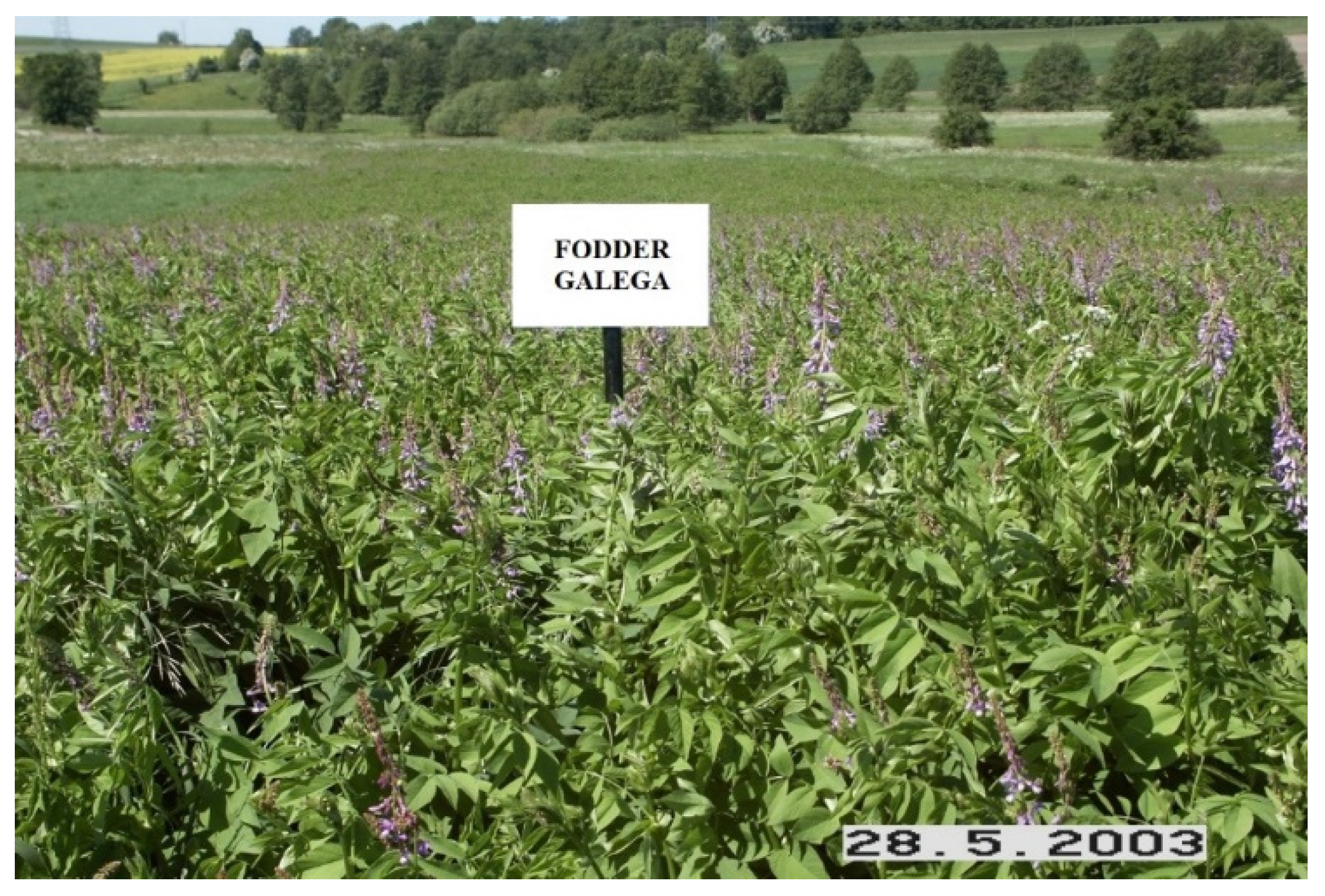
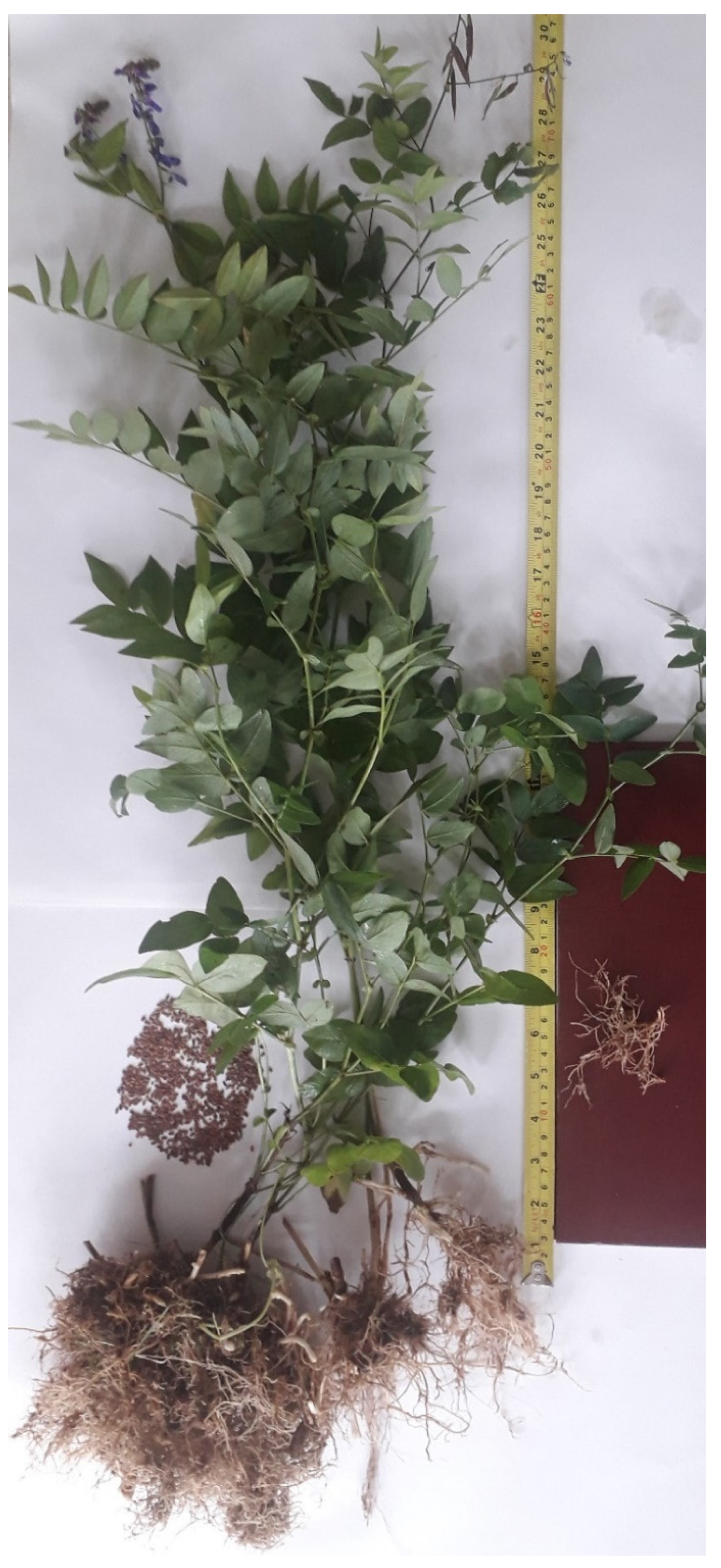
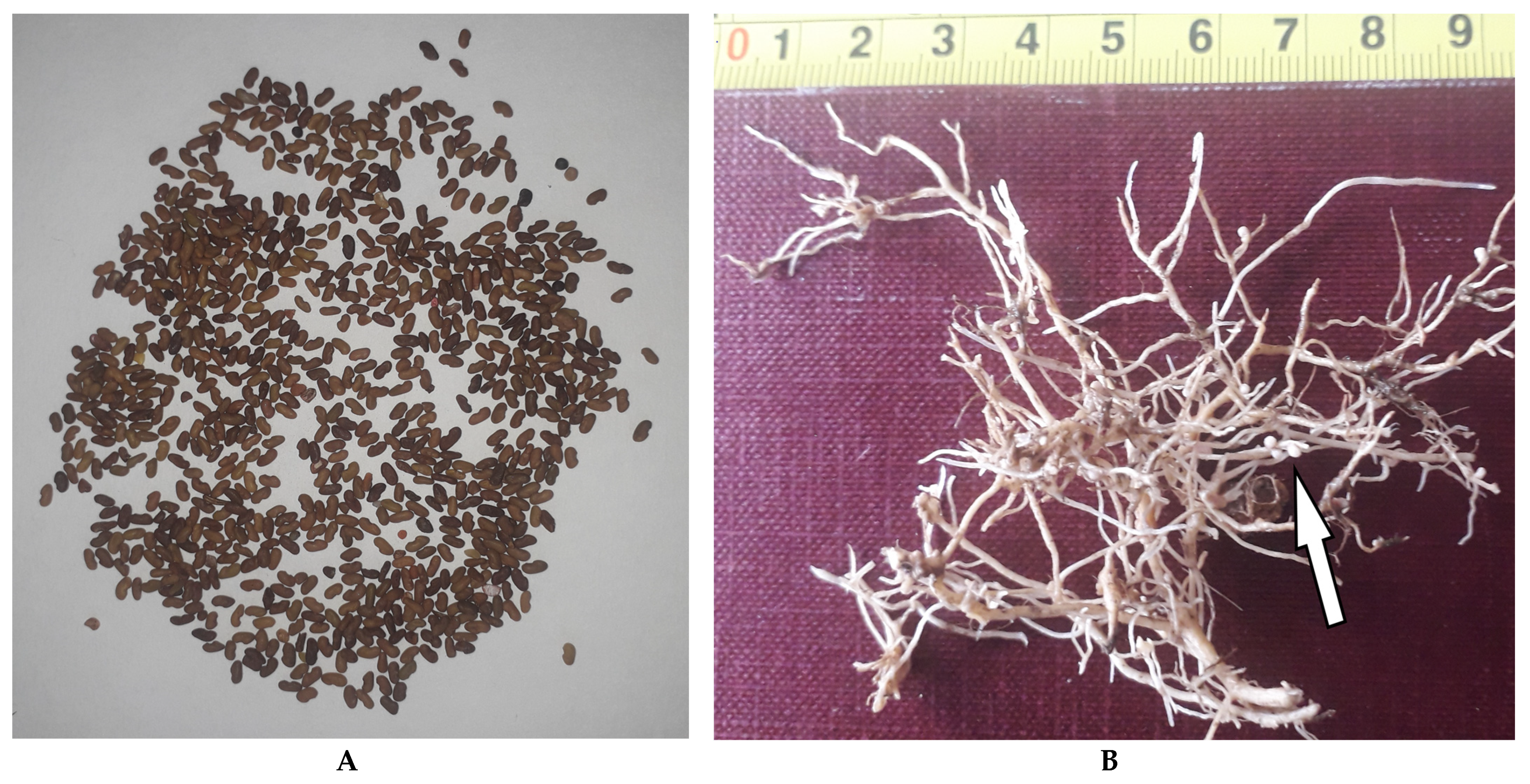
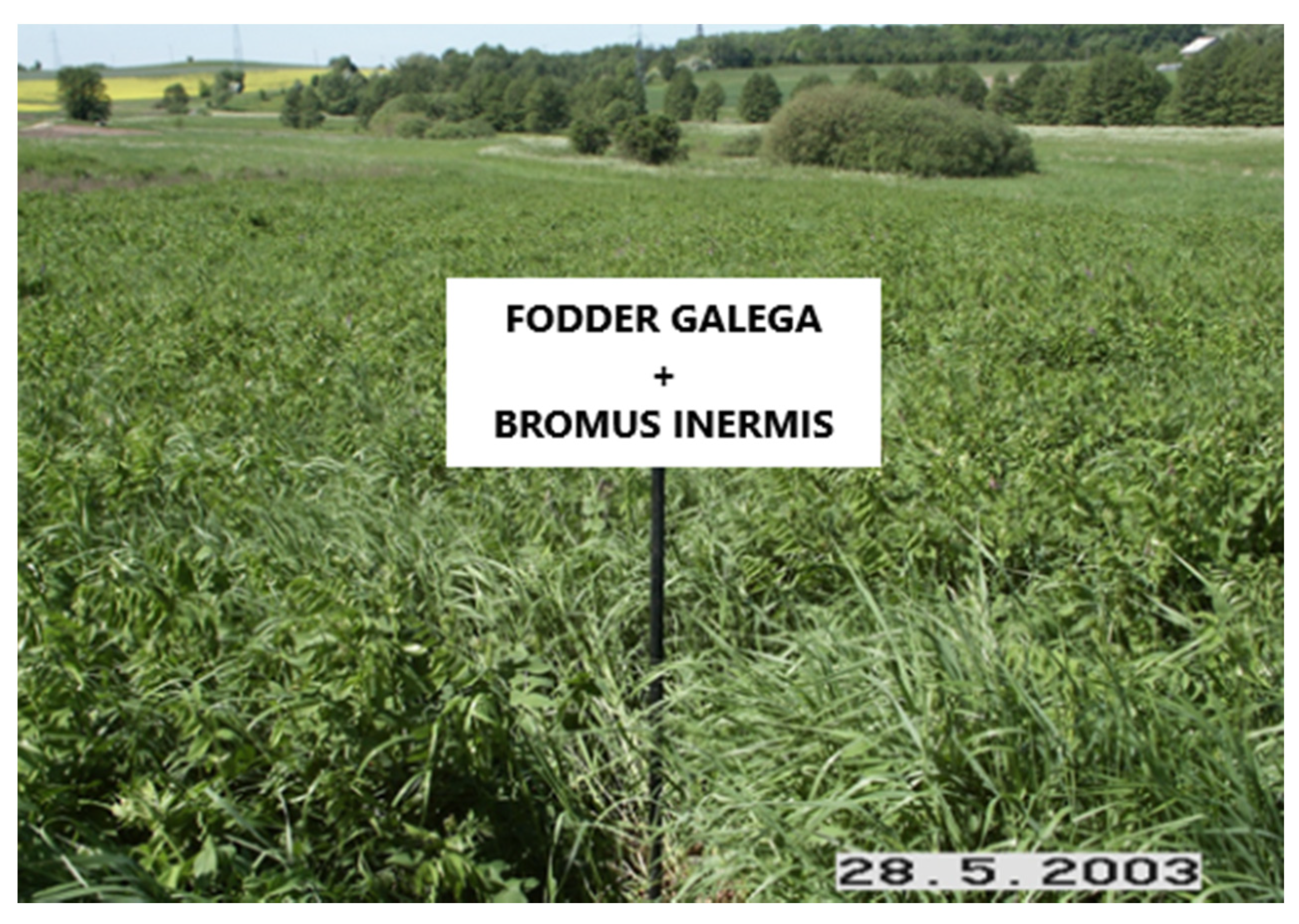
| Month | The First Year |
| April | Sowing with a protective plant, such as oat or barley |
| July | Only one cutting |
| Other months | Plant regeneration |
| The Second Year and Beyond | |
| May/June | First cutting (80–130 cm) * |
| August | Second cutting (50–60 cm) * |
| September | Third cutting (30–90 cm) * |
| Ingredient | Content | Source | |
|---|---|---|---|
| Crude protein | g/kg DM | 197.7–295.0 | [27,35,40,41] |
| Crude fat Crude fibre Lignin | g/kg DM | 29.5 245.8 37.0 | [35] |
| Crude ash | g/kg DM | 86.2–124.8 | [35,40] |
| P K Ca | g/kg DM | 2.1–4.8 28.1–31.7 12.4–17.5 | [14,35,40] |
| Mg | g/kg DM | 2.3–3.6 | [14,20,27,40] |
| Na Si | g/kg DM | 6.1 2.1 | [40] |
| Cu | mg/kg DM | 4.5–8.0 | [20,35,40] |
| Fe | mg/kg DM | 80.0–100.0 | [20,35] |
| Zn Mn Ni Cr Cd Pb | mg/kg DM | 15.0–30.6 12.0–83.8 0.59–1.87 0.76–0.95 0.059–0.15 0.78–1.37 | [35,40] |
| B Hg | mg/kg DM | 18.42 0.012 | [40] |
Publisher’s Note: MDPI stays neutral with regard to jurisdictional claims in published maps and institutional affiliations. |
© 2021 by the authors. Licensee MDPI, Basel, Switzerland. This article is an open access article distributed under the terms and conditions of the Creative Commons Attribution (CC BY) license (https://creativecommons.org/licenses/by/4.0/).
Share and Cite
Żarczyński, P.J.; Sienkiewicz, S.; Wierzbowska, J.; Krzebietke, S.J. Fodder Galega—A Versatile Plant. Agronomy 2021, 11, 1797. https://doi.org/10.3390/agronomy11091797
Żarczyński PJ, Sienkiewicz S, Wierzbowska J, Krzebietke SJ. Fodder Galega—A Versatile Plant. Agronomy. 2021; 11(9):1797. https://doi.org/10.3390/agronomy11091797
Chicago/Turabian StyleŻarczyński, Piotr Jarosław, Stanisław Sienkiewicz, Jadwiga Wierzbowska, and Sławomir Józef Krzebietke. 2021. "Fodder Galega—A Versatile Plant" Agronomy 11, no. 9: 1797. https://doi.org/10.3390/agronomy11091797
APA StyleŻarczyński, P. J., Sienkiewicz, S., Wierzbowska, J., & Krzebietke, S. J. (2021). Fodder Galega—A Versatile Plant. Agronomy, 11(9), 1797. https://doi.org/10.3390/agronomy11091797






